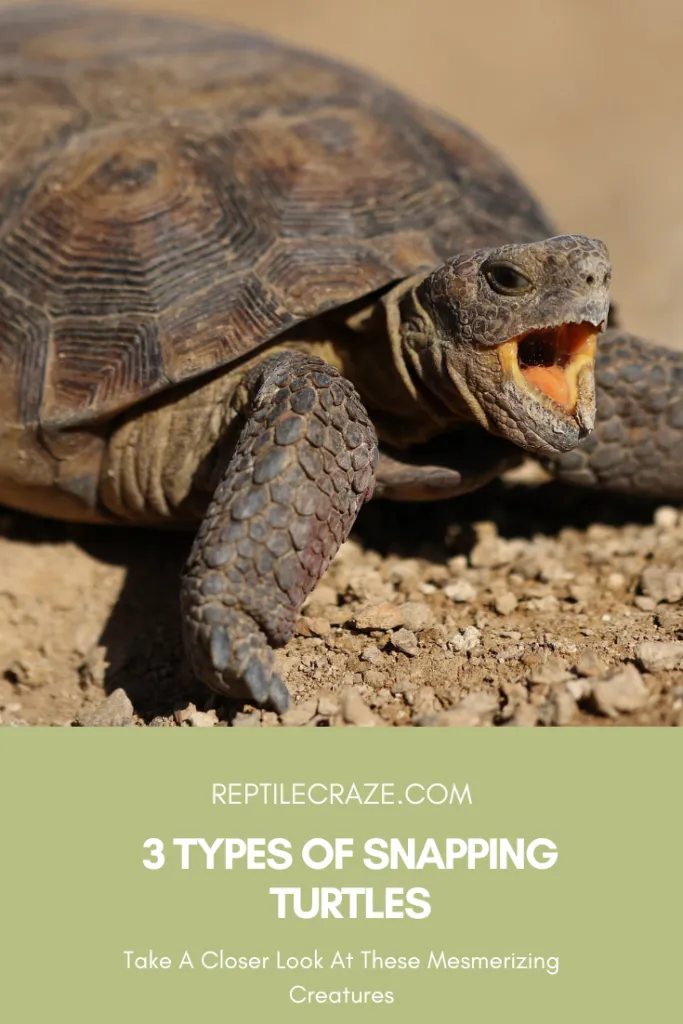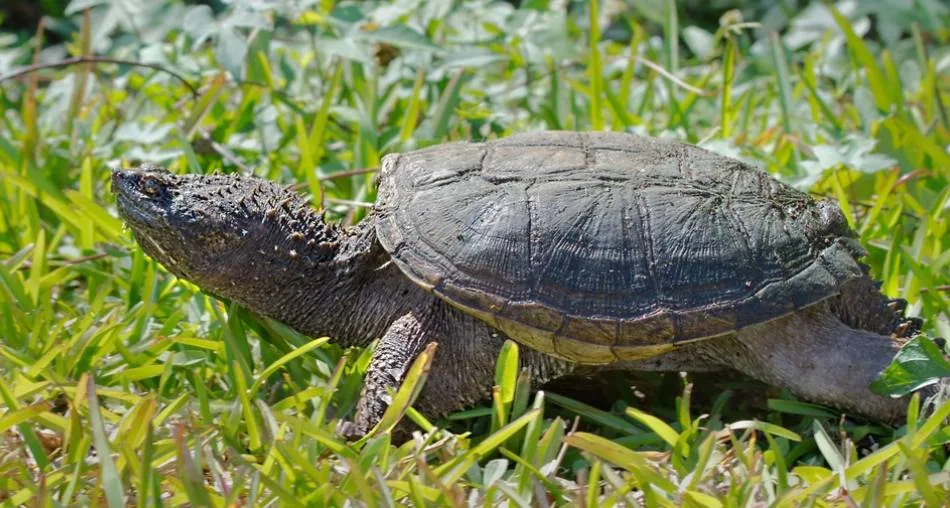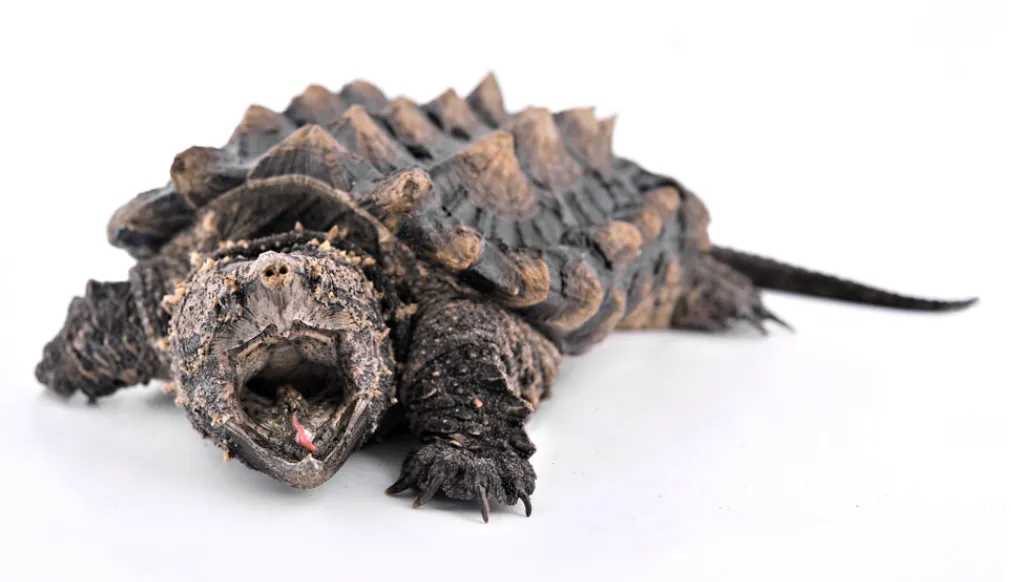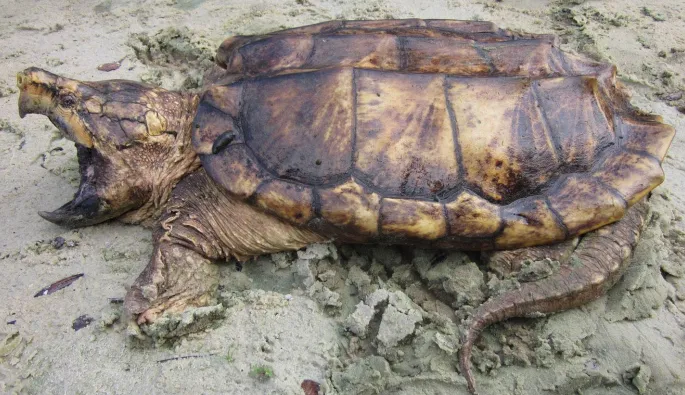Ever paused to really think about turtles? They seem pretty chill, right? Slowly trekking along, their homes snugly fit on their backs, living the sunbather’s dream. But here’s a twist: meet the snapping turtle – the bolder, more mysterious relative in the vast turtle realm. These fellas aren’t your average turtles you’d find lazing about in a pond. Armed with sturdy shells and a bite that packs a punch, they carry a certain swagger. Most known to hang out in North America’s freshwater, snapping turtles, especially the various types of snapping turtles, have a charm that’s raw and untamed.

So, buckle up, because we’re about to delve deeper into the fascinating world of the Common and Alligator Snapping Turtles. There’s more to them than just a snap!
Table of Contents
Common Snapping Turtle

Have you ever heard of the Common Snapping Turtle? Going by its scientific title, “Chelydra serpentina”, this is one fascinating turtle to talk about. Dive in as we unpack the wonders of this unique aquatic buddy.
Anatomy and Appearance
- Proportions: One look and you’ll notice its distinct size. The snapping turtle’s head might look a bit too big, its snake-like neck is pretty elongated, and its tail? It resembles an old-fashioned saw. With its robust carapace (upper shell) acting as a shield and a notably compact plastron (lower shell), it’s fashioned perfectly for its lifestyle.
- Color Dynamics: With colors transitioning from deep blacks to earthy browns, this turtle knows how to blend in, making it a master of camouflage in various aquatic terrains.
- Usual Measurements: A grown snapper’s carapace is about 8 to 14 inches. Weight-wise, they’re no lightweights, tipping scales between 10 to a whopping 50 lbs.
Feeding Habits
Snapping turtles aren’t fussy eaters. From aquatic bugs, fishes, smaller reptiles, to the occasional bird that gets too close – they’ll snack on them all. Dead animals? They’re down for some scavenging. Plus, they enjoy some greenery with aquatic plants in their mix.
Lifestyle and Habits
- Aquatic Life: Water is their main hangout, where they skillfully paddle around with their strong limbs.
- Land Adventures: Though water’s their playground, they’re not strangers to land. Especially the females, who often journey afar to find that prime nesting spot.
- Underwater Exploration: Instead of free-swimming, they often trudge the water bed, feeling the textures beneath.
- Soaking the Sun: Not the regular sun-worshipers, but occasionally, you might spot them floating, basking in sunlight.
Habitual Preferences
- Water Preferences: These turtles fancy water with soft bases, rich with underwater plants.
- Environmental Adaptability: Give them any permanent freshwater setup, be it calm ponds or active streams, and they’ll set up shop.
- Geographical Presence: They majorly chill in North America, from the chill of southeastern Canada to the warmth of Florida.
Reproductive Scoop
- Egg-laying Rituals: Female snapping turtles seek sandy soils for nesting, often exploring multiple sites before finalizing.
- Fertility & Hatchlings: A nest typically houses 20 to 40 eggs, but some ambitious ones might even go up to 80! In about a quarter of a year, tiny snappers emerge.
- Challenges in Nesting: The egg-laying journey isn’t a cakewalk. Road crossings often pose threats, and egg-hungry predators lurk around.
Some More Information
- Why ‘Snapping’: If you’re curious about the “snapping” tag, it’s all about their assertive bite. Mess with them, especially on land, and they snap!
- Defensive Moves: That fierce bite isn’t just for self-defense. It’s a crucial part of their hunting toolkit, letting them grab their prey efficiently.
To sum it up, the common snapping turtle is more than just another turtle. It’s a blend of strength, adaptability, and sheer perseverance. Every shell curve, deliberate stride, and of course, every snap tells a tale. Regardless of whether you’re a reptile aficionado or a casual observer, this turtle is bound to leave an indelible mark on your mind. Quite the creature, isn’t it?
Alligator Snapping Turtle

Have you come across the Alligator Snapping Turtle? Officially known as “Macrochelys temminckii”, this particular turtle isn’t your average slowpoke. Let’s unwrap the enigma of this ancient-looking aquatic marvel.
Anatomy and Appearance
- Proportions: At first glance, what stands out? That dinosaur-like appearance. With a head that could tell a thousand tales, a neck that appears to have witnessed epochs, and a tail that could be straight out of a Jurassic movie, this turtle screams ‘prehistoric’.
- Color Dynamics: Their shells showcase a mosaic of colors – from murky greens to brooding browns, giving them an edge in murky waters, blending seamlessly with their swampy homes.
- Usual Measurements: These aquatic giants are no joke in terms of size. Adult alligator snappers can weigh between 155 to 175 lbs, making them one of the heaviest freshwater turtles.
Feeding Habits
Alligator snappers have a peculiar hunting method. Using a pink, worm-like appendage on their tongues, they lure in unsuspecting fish. They are carnivorous by nature, with fish, frogs, and even other turtles on their menu. Their powerful jaws can deliver a bite that’s legendary, making mealtime an easy task.
Lifestyle and Habits
- Aquatic Life: Swamps, bayous, and muddy rivers are their domains. These ambush predators rely heavily on their stillness, waiting patiently for their prey to come close.
- Land Adventures: While they are dominantly aquatic, females take terrestrial trips during the nesting season.
- Underwater Exploration: Being bottom dwellers, these turtles are more about lying in wait than actively chasing around.
- Soaking the Sun: Basking isn’t really their style. They prefer the cool, dark depths of their aquatic homes.
Habitual Preferences
- Water Preferences: Dark, murky waters of the southern U.S. make the ideal setting. Slow-moving freshwater environments are their preferred haunts.
- Environmental Adaptability: From deep river channels to floodplain swamps, their adaptability is commendable.
- Geographical Presence: Their stomping grounds range from Florida to eastern Texas and up to southern Georgia.
Reproductive Scoop
- Egg-laying Rituals: The female snapper, once she’s found a comfy sandy or muddy spot, lays around 10 to 50 eggs.
- Fertility & Hatchlings: Incubation wraps up in a few months, post which baby snappers, equipped with an egg tooth, break free.
- Challenges in Nesting: Journey to the nesting site isn’t always smooth. Natural predators and even human activities pose threats.
Some More Scoop
- Why ‘Alligator’ Snapper: Those ridges on its shell resemble an alligator’s back, giving it a rough, rugged look, and hence the name.
- Defensive Moves: Though they’re generally placid, when threatened, especially on land, they can deliver a bone-crushing snap.
To sum it up, the Alligator Snapping Turtle is like a cool blast from the past. Its unique shell, skin texture, and of course, that famous snap make it pretty unforgettable. Whether you’re really into reptiles or just find them interesting, this turtle is definitely one to remember. Nature sure knows how to make them stand out!
Suwannee Alligator Snapping Turtle

If you’re into turtles, or even if you’re not, the Suwannee Alligator Snapping Turtle, known scientifically as “Macrochelys suwanniensis”, is one interesting creature you should know about.
Physical Description
- Size: It’s decently big for a turtle. It has a noticeable head, a long neck, and a rugged tail that can remind you of something prehistoric.
- Color: They’re usually dark, going from gray to brown. This helps them blend in with their watery surroundings.
- Growth: They’re not exactly small. These turtles can become quite hefty over time.
Diet
They’re not too picky about what they eat. Their menu includes small aquatic animals, fish, and occasionally other reptiles.
Behavior
- In the Water: Mostly, they prefer staying submerged, swimming around and minding their business.
- On Land: They come out once in a while, especially females searching for a place to lay eggs.
- Movement: Often, instead of swimming, they stroll along the riverbed.
- Sunbathing: You might find one soaking up the sun, floating on the water surface occasionally.
Habitat
- Favorite Places: They like water bodies with a muddy base and plenty of plants.
- Adaptability: They can live in both ponds and streams without much fuss.
- Location: Mostly, they’re found around the Suwannee River in Florida.
Reproduction
- Nesting: Female turtles search for the right spot to lay their eggs, often on sandy or muddy terrains.
- Eggs: A nest usually contains between 20 to 40 eggs, which hatch after a few months.
- Challenges: Finding a safe nesting place isn’t always easy. Roads and predators can be a problem.
More Info
- The Name: “Snapping” in the name is there for a reason – they’ve got a strong bite and they aren’t afraid to use it.
- Feeding: That strong bite is also useful when they eat, helping them hold onto their
food .
In short, the Suwannee Alligator Snapping Turtle is quite a creature. With its distinct features and behavior, it offers a unique look into the world of turtles. Whether you’re a nature lover or just curious, this turtle definitely stands out.
Q&A
– Q: What’s the difference between an alligator snapping turtle and a common snapping turtle?
A: Alligator snapping turtles typically have a more robust and rugged appearance with three distinct rows of spikes on their shells, while common snapping turtles have a smoother shell. The alligator snapper also has a worm-like lure on its tongue to attract prey.
– Q: What is the largest/ heaviest alligator snapping turtle on record?
A: The largest alligator snapping turtle on record weighed approximately 249 pounds.
– Q: In which states can you find alligator snapping turtles?
A: Alligator snapping turtles are primarily found in southeastern U.S. states, from Florida to eastern Texas and up to southern Georgia.
– Q: Why are alligator snapping turtles named as such and why are they important?
A: They are named “alligator” snapping turtles because the ridges on their shells resemble an alligator’s back. They play crucial roles in their ecosystems, helping control fish populations and contributing to biodiversity.
– Q: Are alligator snapping turtles more aggressive than common snapping turtles?
A: Both species can be aggressive when threatened, but generally, alligator snapping turtles are more placid when undisturbed in their natural habitat.
– Q: How can you determine the age of a snapping turtle?
A: Age can be estimated by counting the growth rings on a turtle’s scutes (scales on the shell). However, this method is not always accurate as the rate of ring formation can vary.
– Q: What type of
A: They primarily eat fish but will also consume other aquatic animals like frogs, small reptiles, and even other turtles. They use a unique worm-like lure on their tongue to attract prey.
– Q: Are snapping turtles native to Virginia?
A: Yes, common snapping turtles are native to Virginia, but alligator snapping turtles are not typically found there in the wild.
– Q: Are male alligator snapping turtles larger than females?
A: Yes, male alligator snapping turtles tend to be larger than females. They can exhibit more pronounced features such as a bulkier head and a thicker tail base.
– Q: What conservation efforts are being undertaken to protect the snapping turtles in the United States?
A: In the United States, conservationists are working on several fronts. They’re rehabilitating habitats, creating awareness programs, and regulating hunting and trade of snapping turtles. Some states have also classified them as a protected species, restricting their collection from the wild.
– Q: Do snapping turtles prefer muddy environments?
A: Yes, both alligator and common snapping turtles often inhabit muddy freshwater systems like swamps, marshes, and slow-moving rivers. The mud provides them with camouflage and is also conducive for ambushing prey.
– Q: How many eggs do female snapping turtles lay in their clutches?
A: Female snapping turtles typically lay clutches containing 20 to 40 eggs. However, in some cases, the number can be as high as 80 eggs, depending on the species and the individual turtle’s size.
– Q: Are common snappers more widespread in the United States compared to alligator snapping turtles?
A: Yes, common snappers have a broader range across the United States, found from the Rocky Mountains to the Atlantic Coast. In contrast, alligator snapping turtles are primarily found in the southeastern U.S.
– Q: During which months are snapping turtles typically more active in laying eggs?
A: Female snapping turtles usually lay their eggs between April and November, with the peak nesting period occurring in early summer.
– Q: How do wildlife experts monitor the health of snapping turtle populations in the Gulf of Mexico?
A: Wildlife experts in the Gulf of Mexico region often conduct regular surveys, tagging programs, and habitat assessments to monitor the health and population sizes of snapping turtles in the area.
– Q: Are crows a threat to snapping turtle eggs?
A: Yes, crows, along with other predators like raccoons and mink, can pose a threat to snapping turtle eggs, often digging them up from nests to eat.
– Q: Does the genus *Macrochelys* refer to all snapping turtles?
A: No, the genus *Macrochelys* specifically refers to the alligator snapping turtle. The common snapping turtle, on the other hand, belongs to the genus *Chelydra*.
– Q: Are there any snapping turtles in South America?
A: Snapping turtles are primarily native to North America. South America doesn’t have native snapping turtles, but there might be isolated cases due to pet trade releases or other human activities.
– Q: How has habitat loss affected the snapping turtle populations?
A: Habitat loss, often due to urbanization, pollution, and agricultural practices, has had a negative impact on snapping turtle populations, leading to decreased nesting sites and increased mortality rates.
– Q: Is there a difference in the genera of snapping turtles?
A: Yes, snapping turtles belong to two primary genera: *Chelydra*, which includes the common snapping turtle, and *Macrochelys*, which is home to the alligator snapping turtle.
– Q: What is the average weight of adult snapping turtles?
A: Adult common snapping turtles can weigh between 10 to 35 lbs on average, while adult alligator snapping turtles can weigh significantly more, with some reaching over 150 lbs.
– Q: Are snapping turtles found in Ontario?
A: Yes, the common snapping turtle is native to Ontario and is the province’s largest freshwater turtle.
– Q: What determines a snapping turtle’s clutch size?
A: Clutch size in snapping turtles can be influenced by factors such as the turtle’s age, size, health, and environmental conditions.
– Q: Are minks predators of snapping turtles?
A: Minks primarily target smaller prey, but they can be opportunistic predators of young snapping turtles or their eggs. Adult snapping turtles are generally safe from minks due to their size.
– Q: At what age do snapping turtles generally attain sexual maturity?
A: Typically, snapping turtles reach sexual maturity between 5 to 7 years, but this can vary based on environmental factors and specific conditions.
– Q: How often do coyotes interact with snapping turtles?
A: Coyotes might occasionally prey on snapping turtle eggs or juvenile turtles, but adult turtles, with their protective shell, are usually not targeted.
– Q: Are bullfrogs a common meal for snapping turtles?
A: Yes, snapping turtles, particularly the younger ones, will prey on bullfrogs when given the opportunity.
– Q: Do great blue herons pose a threat to snapping turtles?
A: Great blue herons primarily eat fish, but they might attempt to prey on small, young snapping turtles. Adult snapping turtles are usually too large for herons to handle.
– Q: What is the average weight in kg of an adult snapping turtle?
A: Adult snapping turtles can vary in weight, but common snappers typically weigh between 4.5 to 16 kg, with some exceptional individuals being heavier.
– Q: How long, in cm, can a snapping turtle’s shell grow?
A: The carapace (upper shell) of a common snapping turtle can range from 25 cm to 50 cm in length, depending on the age and health of the individual.
– Q: How important is aquatic vegetation to the diet of snapping turtles?
A: Aquatic vegetation plays a supplementary role in the diet of snapping turtles. While they’re primarily carnivorous, snapping turtles do consume aquatic plants, which provide essential nutrients and dietary balance.
– Q: What species belong to the genus Macrochelys?
A: The most renowned species under the genus Macrochelys is the alligator snapping turtle, Macrochelys temminckii. It’s known for its formidable size and unique hunting techniques.
– Q: Do snapping turtles prey on small mammals?
A: Yes, snapping turtles are opportunistic predators. If small mammals like mice or shrews are within reach, especially at the water’s edge, they can become a meal for the turtle.
– Q: Is June a significant month for snapping turtles in any way?
A: Indeed, June is a pivotal month for many snapping turtles as it’s a common period for females to venture onto land to lay their eggs. Nesting typically occurs in early summer.
– Q: What species are part of the family Chelydridae?
A: The family Chelydridae includes the common snapping turtle (Chelydra serpentina) and the alligator snapping turtle (genus Macrochelys). These are the primary representatives of this family known for their powerful snapping mechanism.
- Enchi Ball Python: A Unique and Stunning Morph of Python regius - March 27, 2025
- Emerald Tree Monitor: The Enigmatic Green Guardian of the Rainforest - March 26, 2025
- The Egyptian Cobra (Naja haje): A Fascinating Serpent - March 25, 2025
